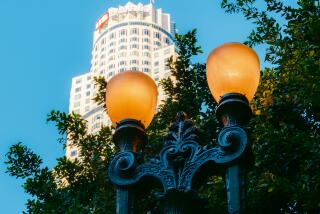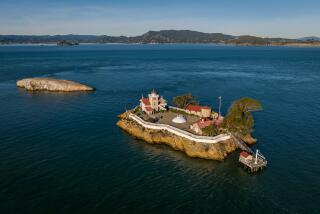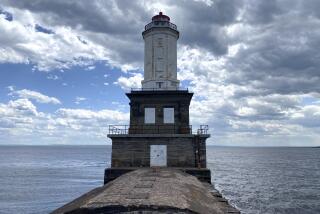Chance to live in a lighthouse is a beacon for buyers
WASHINGTON — A construction worker, a nanny and a clothing designer walk into a lighthouse.
It sounds like the beginning of a bad joke, but the government couldn’t be happier with the punch line.
The lighthouse, you see, is surplus federal property -- and if these visitors like what they see, they’ll bid against one another for the privilege of purchasing the dilapidated, rusting structure with a 360-degree view of Mount Hope Bay in Massachusetts.
The government’s annual lighthouse auction, which began three years ago as an effort to rid the cash-strapped Coast Guard of these obsolete towers, has turned into a much-anticipated and lucrative event, drawing dozens of bidders from around the country.
Like Victrola collectors or Studebaker fanatics, the prospective purchasers of the Borden Flats Lighthouse, about a quarter-mile offshore from Fall River, Mass., are plunging checkbook-first into a burgeoning antiquarian market.
“Certainly life is too short not to experience everything you can,” said nanny Nicole Kimborowicz, who bid $40,000 for Borden Flats. “To be within arm’s reach of humanity but experience the world in a whole different way is quite intriguing to me.”
About 450 lighthouses still stand in the United States, most of them towering over the Great Lakes and the Atlantic Ocean. Historically, they played a vital role in the transport of goods, serving as flashing signs along an unpaved highway, warning ships of jagged coastlines and hazardous shoals and reefs.
Through the 1800s and into the 1900s, lighthouse keepers and their families vigilantly maintained the buildings and the lights -- trimming wicks, refilling fuel, cleaning lenses. But with the advent of electricity and improvements in navigation technology, the job faded into extinction. Since 1939, the Coast Guard has been responsible for the structures, but many have fallen into disrepair, used more by sea gulls than seafarers.
“It was awful -- anything a sea gull could leave behind, it did,” said Bob Gonsoulin, who purchased Middle Ground Lighthouse, near Newport News, Va., in 2005. “Everything was white with sea gull poop. There were dead sea gulls, fish and eggs everywhere. The floor was rotting. There was lead paint and no windows.”
The neglect of the singular structures prompted Congress to pass the National Historic Lighthouse Preservation Act of 2000. Those deemed to be surplus are first offered to local governments and nonprofits at no charge. If they remain unclaimed, they are auctioned online.
So far, almost 50 have been transferred or sold, with the most expensive -- Chesapeake Bay’s Baltimore Harbor Light -- going for $260,000. This auction season, at least seven are expected to land in private hands, including Borden Flats, which was purchased Sept. 22 for $55,000. The winner, not yet publicly identified, has 60 days to close the sale.
Potential bidders must make a refundable deposit of about $10,000. The auction opens at about $5,000, and competition can get fierce.
“At some point we were in a bidding war,” said Aimee Russell, a first mate on a private yacht, who won the Baltimore Harbor Light auction in 2006 with her husband and their friends.
“We were bidding back and forth,” said co-owner Jane Cox. “You have to put your money where your mouth is.”
To get that money, members of the group refinanced their homes. They now spend much of their free time at the lighthouse, more than a mile and a half off the western shore of Chesapeake Bay -- chipping off old paint, redoing woodwork and worrying about installing impact-resistant but historically accurate windows, which can cost about $1,000 each.
Since the program began, every released lighthouse but one has been considered historically significant, said Ralph Conner, director of real property utilization at the General Services Administration, the federal agency that oversees the lighthouse transfers. As a result, proposed renovations must be cleared with state historic preservation offices.
“You won’t be seeing an advertising billboard on these lighthouses or someone coming in and painting them fuchsia,” he said.
Gonsoulin and his extended family paid $31,000 for their lighthouse three years ago. They have invested about $130,000 to transform the tower, which resembles a red wedding cake, into a comfortable spot -- complete with glossy paint, finished floors and a flat-screen TV -- for relaxing and enjoying the view of passing ships in one of the country’s busiest harbors.
But one question inevitably follows those who decide to invest so much in what appears to be so little: Why?
For some who make it their business to collect unusual things, a lighthouse is simply the ultimate novelty item. For others, there are more nostalgic undercurrents.
Lighthouses, particularly on the East Coast, where U.S. maritime commerce began, have long enjoyed a cult following.
To enthusiasts they symbolize a kind of purposeful seclusion, inextricably tied to a time of tall ships and treacherous sea crossings.
“They are a link to our maritime past, and this country was built on maritime trade,” said Jeremy D’Entremont, vice president and historian of the American Lighthouse Foundation. “Lighthouses and lighthouse keepers were responsible for the safe movement of commerce. The people who lived in the lighthouses were so completely dedicated to keeping the light lit, no matter what.”
Clothing designer Wayne Keller, who traveled all the way from Colorado to see Borden Flats, put it this way: “A lighthouse is a beacon into the night. I like the ocean. I like the solitude.”
Study lighthouse history for any length of time, however, and the challenging realities of life on the water begin to encroach on romantic visions of ivory towers in the waves. Starting with the first American lighthouse keeper, George Worthylake, who drowned along with his wife and daughter when returning to Boston Light on Little Brewster Island in 1718, those who call these buildings home have been known to lose their lives maintaining the structures that were intended to save others.
D’Entremont, who has written five books on the structures, said he worries that the potential danger and inherent difficulty of caring for a lighthouse, particularly one offshore, may pose problems for today’s would-be owners.
“I am not really a fan of auctioning lighthouses to the public,” he said. “I think it is a real roll of the dice.
“Even in the best-case scenario, the people buying the lighthouses are not going to be around forever, and the rest of the people in the family may not be into that,” he said.
Yet despite D’Entremont’s misgivings, the 21st century lighthouse keepers say they are up to the task -- and are better than the alternative.
“I think most people are just really happy to see the lighthouse being used,” Cox said. “You know, at least twice a weekend we’ll be out here painting something, or hammering something, and somebody will go by and say: ‘Hey, how’s it going? Looks great. Thank you.’ ”
--
--
On latimes.com
More lighthouses
A video tour and photo gallery are at latimes.com/lighthouse.
More to Read
Sign up for The Wild
We’ll help you find the best places to hike, bike and run, as well as the perfect silent spots for meditation and yoga.
You may occasionally receive promotional content from the Los Angeles Times.






